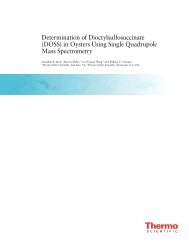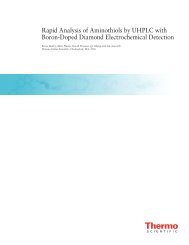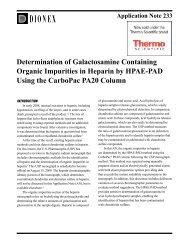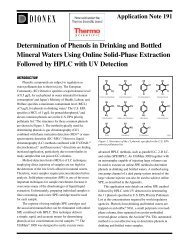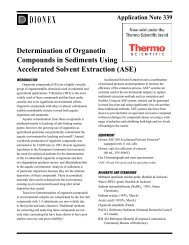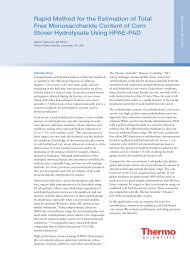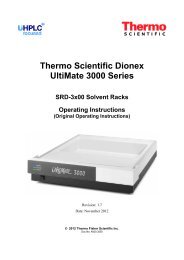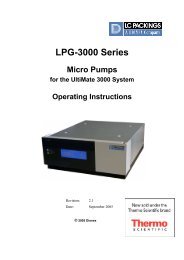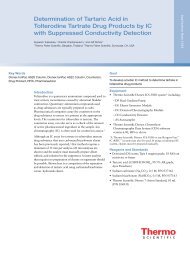AN96: Determination of N-Methylcarbamates by Reversed ... - Dionex
AN96: Determination of N-Methylcarbamates by Reversed ... - Dionex
AN96: Determination of N-Methylcarbamates by Reversed ... - Dionex
Create successful ePaper yourself
Turn your PDF publications into a flip-book with our unique Google optimized e-Paper software.
ReageNTS aND STaNDaRDS<br />
Water, Milli-Q water from Milli-Q Gradient A10<br />
Methanol (CH 3 OH), Fisher, HPLC grade<br />
Acetonitrile (CH 3 CN), Fisher, HPLC grade<br />
Potassium dihydrogen citrate (KC 6 H 7 O 7 ), Fluka, ≥ 98%<br />
Sodium thiosulfate (Na 2 S 2 O 3 ), Fluka, ≥ 98%<br />
Hydrolysis Reagent (0.2% NaOH), Pickering,<br />
chromatographic grade (P/N CB130)<br />
o-Phthalaldehyde (OPA, C 8 H 6 O 2 ), Pickering,<br />
chromatographic grade, (P/N O120)<br />
OPA Diluent (0.4% sodium borate solution), Pickering,<br />
chromatographic grade (P/N CB910)<br />
Mercaptan Reagent, (Thi<strong>of</strong>luor (CH 3 ) 2 NCH 2 CH 2 SH•HCl),<br />
Pickering, chromatographic grade (P/N 3700-2000)<br />
531.2 Carbamate Pesticide Calibration Mixture, Restek,<br />
100 µg/mL (P/N 257974)<br />
4-Bromo-3, 5-dimethylphenyl-N-methylcarbamate<br />
standard, Restek, 100 µg/mL (P/N 32274)<br />
pRepaRaTION Of ReageNTS aND STaNDaRDS<br />
Reagent WaterStock Standard Solutions<br />
Deionized water, Type I reagent grade, 18 MΩ-cm<br />
resistivity or better<br />
Preserved Reagent Water<br />
Dissolve 4.7 g potassium dihydrogen citrate and<br />
160 mg Na 2 S 2 O 3 in a 50 mL beaker with reagent water,<br />
transfer this solution to a 500 mL volumetric flask and<br />
bring to volume with reagent water. Prior to use, filter the<br />
solution through a 0.45-µm filter.<br />
Stock Standard Solutions <strong>of</strong> Carbamate Pesticide<br />
Calibration Mixture<br />
Pipet 10 µL and 100 µL 531.2 carbamate pesticide<br />
calibration mixture (100 µg/mL) into two 1 mL vials, add<br />
990 µL to vial one and 900 µL methanol to vial two. The<br />
concentrations <strong>of</strong> stock standard solutions <strong>of</strong> the calibration<br />
mixture are 1.0 µg/mL and 10 µg/mL, respectively.<br />
Stock Standard Solution <strong>of</strong> 4-Bromo-3,5-dimethyl-<br />
phenyl-N-methylcarbamate Standard (Surrogate Analyte,<br />
SUR)<br />
Pipet 100 µL 4-bromo-3, 5-dimethylphenyl-N-methylcarbamate<br />
standard (100 µg/mL) into a 1 mL vial, and<br />
add 900 µL methanol. The concentration <strong>of</strong> the stock<br />
standard solution <strong>of</strong> the standard is 10 µg/mL.<br />
2 <strong>Determination</strong> <strong>of</strong> N-<strong>Methylcarbamates</strong> <strong>by</strong> <strong>Reversed</strong>-Phased HPLC<br />
Table 1: Preparation <strong>of</strong> calibration curve standards<br />
Stock std.<br />
<strong>of</strong> carbamate<br />
cal. mixture<br />
(µg/mL)<br />
Vol. <strong>of</strong> stock<br />
std. <strong>of</strong><br />
carbamate<br />
cal. mixture<br />
(µL)<br />
Vol. <strong>of</strong> 10<br />
µg/mL stock<br />
std. <strong>of</strong> SUR<br />
(µL)<br />
Final vol.<br />
<strong>of</strong> cal.<br />
std. (mL)<br />
Final conc.<br />
<strong>of</strong> cal. std.<br />
(µg/L)<br />
Final conc.<br />
<strong>of</strong> SUR<br />
(µg/L)<br />
1.0 5.0 5.0 25 0.20 2.00<br />
1.0 12.5 5.0 25 0.50 2.00<br />
1.0 25.0 5.0 25 1.00 2.00<br />
10.0 5.0 5.0 25 2.00 2.00<br />
10.0 12.5 5.0 25 5.00 2.00<br />
10.0 25.0 5.0 25 10.0 2.00<br />
Working Standard Solutions<br />
Prepare six working standard solutions <strong>by</strong> adding the<br />
quantities <strong>of</strong> carbamate mixture stock standard solutions<br />
listed in Table 1 to separate 25 mL volumetric flasks.<br />
Add 5 µL <strong>of</strong> the stock standard solution <strong>of</strong> 4-bromo-3,<br />
5-dimethylphenyl-N-methylcarbamate into each flask.<br />
Bring to volume with preserved reagent water.<br />
Sodium Hydroxide Hydrolysis Reagent<br />
(Post Column Reagent 1)<br />
Decant the hydrolysis reagent into a clean reagent<br />
reservoir that has been rinsed with methanol. Because<br />
high-purity sodium hydroxide is difficult to purchase as<br />
well as prepare, we strongly recommend the use <strong>of</strong> this<br />
reagent for optimum system performance. This reagent<br />
also contains an antifouling additive to prevent mineral<br />
buildup inside the reactor.<br />
OPA Reagent (Postcolumn Reagent 2)<br />
Decant the contents <strong>of</strong> the OPA diluent into a clean<br />
reagent bottle that has been rinsed with methanol. Sparge<br />
the diluent for approximately 10 min to remove oxygen.<br />
Note: The remaining steps should be accomplished<br />
quickly because the prepared reagents are sensitive to<br />
oxygen and light. Weigh approximately 100 mg <strong>of</strong><br />
o-phthalaldehyde into a small beaker, dissolve in 10 mL<br />
methanol, and add to the OPA diluent. Rinse the beaker<br />
with 1 to 2 mL <strong>of</strong> methanol and add this to the diluent.<br />
Add 2 g <strong>of</strong> Thi<strong>of</strong>luor to the reagent bottle, replace the cap,<br />
and sparge for 1 to 2 min. Swirl the bottle gently to<br />
ensure complete mixing.<br />
Tap Water Sample Preparation<br />
The tap water sample was obtained at the <strong>Dionex</strong><br />
(Shanghai) Application Lab located in the Pudong<br />
District, Shanghai, China.




